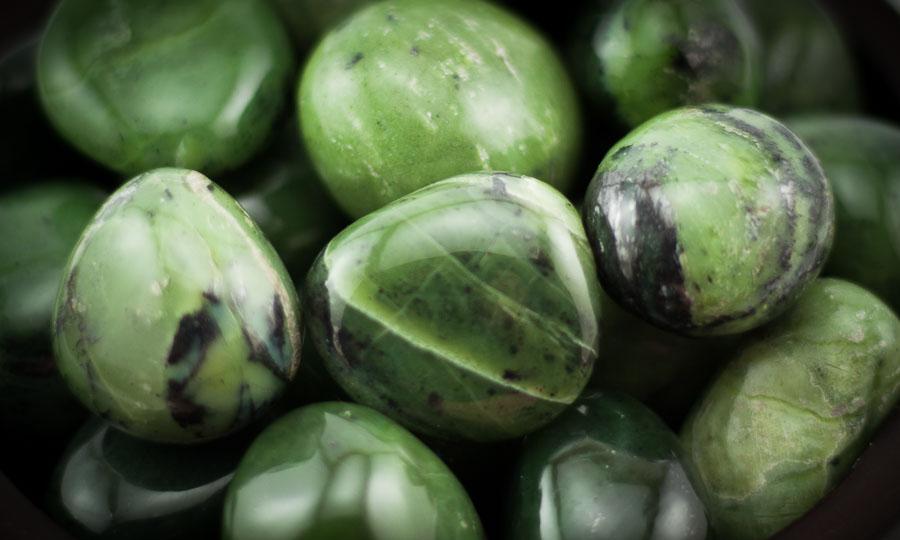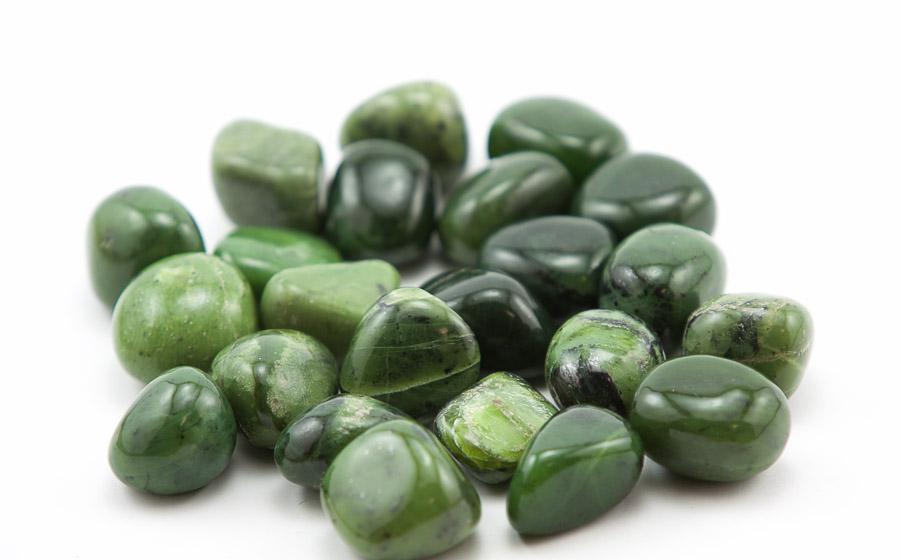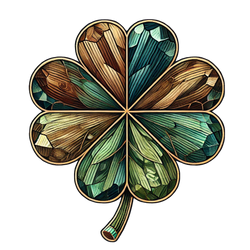You will not be allowed to compare more than 4 products at a time
View compareSerpentine Tumbled 1 lb
Serpentine Tumbled 1 lb
Estimate delivery times:5-8 days.
Flat Rate Shipping and FREE Shipping on orders more than $100.
About This Product
Serpentine – Earth’s Ancient Green Guardian
Introduction
Serpentine is a gemstone of rich, earthy elegance – a tapestry of green hues that range from pale spring moss to deep forest emerald. Its polished surface often glows with a waxy to silky luster, as if lit from within by a soft light. Marbled patterns wind across the stone like verdant snakeskin, giving Serpentine its name (from Latin serpentinus, “serpent rock”) in homage to those sinuous, scaled motifs. Some pieces are dappled with mossy greens and golden veins, evoking ancient forests or lichen-clad stones in a sacred grove. To hold Serpentine is to feel a cool, “slippery” touch – almost greasy like soapstone – grounding you instantly with the sensation of old earth and whispering of primeval origins. In both appearance and energy, Serpentine is a fragment of the ancient Earth, polished to silky perfection yet retaining the wild, coiled vitality of nature.
Historical and Cultural Background
Since antiquity, Serpentine has been treasured by civilizations across the world. Archaeological records show that as early as 3500 BCE, peoples of Mesopotamia and Egypt were carving Serpentine into cylinder seals and amulets. Its smooth, oily finish when polished made it ideal for sealing clay documents (the wax or clay wouldn’t stick to it), and its green color was often associated with life and fertility in those cultures. In the classical world, Greeks and Romans admired Serpentine’s beauty in architecture and art. The Romans quarried a green Serpentine breccia (later called verde antique) for use as decorative columns, floor inlays, and wall facings in villas, temples, and bathhouses. To them, Serpentine was not only ornamental but also imbued with protective power – European lore from ancient through medieval times held that “serpent-stone” could guard against snake bites and poison. Many wore it as a talisman; sorcerers and healers ground it into potions, believing it could draw out venom and evil spirits.
Across the oceans, Serpentine also earned a sacred reputation in the Americas. In Mesoamerica, it was highly valued by civilizations like the Olmec, Maya, and Aztec, who carved the stone into masks, figurines, and ritual ornaments. A famous example is a delicately carved green Serpentine mask found beneath the Pyramid of the Sun in Teotihuacan, Mexico – buried as an offering to the rain god Tlaloc around 2000 years ago. Such finds reveal that Serpentine was used in ceremonies to invoke protection and favor from the gods. Indigenous peoples of North America also shaped Serpentine into beads and small tools, drawn to its availability and the ease with which it could be shaped. In many cultures, the snake-like patterns in Serpentine symbolized a connection to serpent deities and earth spirits – a tangible piece of the living Earth’s power. Through Greek and Roman antiquity, Asian empires, and New World civilizations alike, Serpentine has been a stone of protection, healing, and spiritual significance, its legacy woven into amulets, architecture, and myth across time.
Metaphysical Symbolism and Healing Energy
In metaphysical traditions, Serpentine is esteemed as a stone of grounding and transformation. It carries a steady, ancient energy that helps anchor one’s spirit to the Earth’s subtle vibrations, imparting a sense of stability and peace. Working with Serpentine is said to awaken the kundalini – the latent “serpent energy” coiled at the base of the spine – gently unblocking and guiding this energy up through the chakras for spiritual awakening. As this serpent power rises, it can ignite profound transformation within, much like a snake shedding its old skin. Serpentine’s green ray especially resonates with the heart chakra, opening pathways to emotional healing and compassion. It encourages the release of past trauma, clearing away stagnant emotions and “old programs” to make space for personal growth and love.
At the same time, Serpentine remains closely tied to the root chakra at the spine’s base – connecting our energy to the core of the Earth for deep grounding. This dual chakra influence (root and heart) means Serpentine helps align our survival instincts with our capacity for love, creating an inner balance between security and openness. Healers often use Serpentine for detoxification and clearing on both physical and energetic levels. In crystal healing lore, it’s a potent cleansing stone, thought to purify the body of toxins and the aura of negativity. Traditionally, it has even been used to help absorb or neutralize poisons – a reflection of the old belief in its anti-venom properties. On an energetic level, Serpentine is believed to form a protective shield against electromagnetic stress and pollutant energies, “aligning your energy field with the Earth” to recharge and strengthen the body’s natural defenses. Meditating with Serpentine can feel like tapping into ancient earth wisdom; it facilitates access to past-life memories and the deep heartbeat of nature, allowing spiritual seekers to commune with ancient Earth energies and the archetypal serpent wisdom of transformation. In essence, Serpentine symbolizes rebirth, longevity, and the cyclical renewal of life – a stone that both grounds you in the here and now and propels you toward spiritual evolution.
Decorative and Luxury Appeal
Beyond its spiritual virtues, Serpentine has long been prized as a decorative stone, exuding an organic luxury that appeals to artisans and collectors alike. Its relative softness and fine grain make it a sculptor’s delight – yielding easily to carving tools yet taking on a lustrous polish. For this reason, Serpentine has been used for millennia to create everything from jewelry to grand artworks. In ancient China and India, it was carved into intricate ornaments, sometimes mistaken for or intentionally passed off as jade due to its similar green beauty. Even today Serpentine is often marketed under names like “New Jade” or “Suzhou Jade,” valued as an affordable alternative to true jade. Jewelers turn high-quality Serpentine (especially the harder varieties like bowenite) into cabochons, beads, and pendants with a soft, herbal-green glow. Worn against the skin, a Serpentine necklace or bracelet imparts a subtle earthy elegance – a statement both of natural style and spiritual intent. Some artisans carve Serpentine into the forms most befitting its character: snakes, dragons, and sacred symbols. A coiled serpent figurine or a dragon pendant carved from Serpentine seems almost destined – the stone embodying the very creature it’s named after. These carvings are popular in metaphysical circles and fine art collections, believed to amplify the stone’s protective and wise qualities in the likeness of serpent or dragon guardians.
Serpentine’s appeal extends to interior décor and architecture as well. Polished Serpentine marble (often called Verde Antique) has been a favorite of builders since classical times, used as a luxurious green stone for columns, flooring, and wall panels in palaces and temples. Its forest-green and black mottling, shot through with white or gold veins, creates a striking natural pattern that has adorned churches in Italy and grand halls in Britain. In the modern era, designers still incorporate Serpentine in upscale homes and buildings – for example, as decorative tiles, fireplace surrounds, or countertop inlays that bring a touch of ancient nature into contemporary spaces. Sculptors around the world also continue to embrace Serpentine for large-scale artworks. In Zimbabwe, for instance, Serpentine from the Great Dyke is the primary medium for the renowned Shona stone sculptures; local carvers refer to its varieties by names like “springstone” or “opal stone” and celebrate its durability and beautiful polish in both indoor and outdoor art. These sculptures, often depicting tribal spirits or graceful wildlife, highlight Serpentine’s ability to hold fine detail and shine with a waxen glow after hand-waxing and buffing. Whether as a small tumbled stone anchoring the energy of a personal altar, or as an ornamental pillar in a cathedral, Serpentine carries an aura of timeless, earthly splendor. Collectors cherish finely patterned Serpentine specimens for their display cases, while healers place raw green chunks on altars to symbolize the presence of Earth in ritual. Versatile and enduring, Serpentine seamlessly bridges the gap between natural beauty and artistic luxury – equally at home in a gemstone collection, a metaphysical toolkit, or the architecture of the world’s most opulent spaces.
Scientific Profile of Serpentine
Despite its poetic presence, Serpentine is very much a scientifically fascinating mineral group. Below is a breakdown of its key mineralogical properties:
-
Chemical Composition: (Mg,Fe)₃Si₂O₅(OH)₄ – Serpentine is a family of magnesium iron silicate hydroxides. In pure form it approaches Mg₃Si₂O₅(OH)₄ (magnesium silicate hydroxide), but iron (Fe) often substitutes for some of the magnesium, and trace elements like nickel or chromium can be present. This composition is essentially that of hydrated olivine, formed when ultramafic rocks undergo water-rich metamorphism (the process of serpentinization).
-
Crystal System: Monoclinic for most Serpentine minerals (they belong to the sheet silicate, or phyllosilicate, family). However, polymorphs vary – for example, antigorite and clinochrysotile are monoclinic, orthochrysotile is orthorhombic, and lizardite commonly has a hexagonal form. In practice, Serpentine rarely forms distinct visible crystals; it usually occurs in massive or fibrous habits, so crystal system is determined by X-ray methods rather than crystal shape.
-
Mohs Hardness: About 3 to 5 on the Mohs scale, depending on variety. Common Serpentine (lizardite/antigorite) typically falls around 3–4, which is relatively soft (softer than quartz or turquoise). However, certain varieties like bowenite (a form of antigorite) can reach around 5.5, approaching the hardness of true jade. This moderate hardness makes Serpentine easy to carve and polish, though softer pieces may scratch or wear with heavy use.
-
Luster: Waxy to silky in most specimens. Fine-grained Serpentine often has a greasy or oily sheen, especially when polished, giving it a soapy or resinous look. Fibrous forms (like chrysotile asbestos) can exhibit a soft silky or pearly luster along the fibers. The luster contributes to Serpentine’s smooth “glow” rather than a sharp sparkle.
-
Transparency: Opaque in the vast majority of pieces. Translucency is seen in thin slices or high-quality chunks, which may show a muted glow of light through green edges. Fully transparent Serpentine is exceedingly rare to nonexistent. Most jewelry-grade material is opaque, sometimes with a slightly cloudy translucence at the edges or in thin slivers.
-
Cleavage & Fracture: Cleavage is present but varies by type – the platy varieties (antigorite, lizardite) have one direction of perfect cleavage (splitting easily into thin sheets), whereas fibrous chrysotile has no true cleavage. Fracture in Serpentine is typically uneven to conchoidal in massive pieces (it breaks in curved, shell-like surfaces). Fibrous forms tend to splinter. This means a chunk of Serpentine might break with rough or curved surfaces rather than clean planar faces, except in those layered varieties that can cleave into plates.
-
Habit: Massive, fibrous, or scaly aggregates. Serpentine does not form large single crystals but occurs as massive chunks, fine fibrous veins, or lamellar (scale-like) masses in rock. Antigorite often shows a scaly or banded texture; lizardite usually appears as fine-grained or massive blobs; chrysotile forms silky fibers (the asbestos habit) woven through serpentine rock (serpentinite). Many serpentinite rocks have a green mottled appearance with smooth, rounded surfaces – a result of the mineral’s habit of filling veins and altering matrix rock.
-
Major Sources: Found worldwide; notable sources include the United States (especially California, the official state rock, as well as Arizona and New England), China, Afghanistan, South Africa (and Zimbabwe), New Zealand, Italy, Greece, and the UK. In the US, California’s Coast Ranges are rich in serpentine; in China, the Xiuyan region yields the so-called “Xiuyu jade” serpentine; Afghanistan produces “Afghan jade” used in carvings; New Zealand’s opaque green tangiwai is a bowenite serpentine treasured by Māori artisans; Italy (such as in the Alps and Apennines) has classic serpentine marbles used since Roman times. Wherever ancient oceanic crust or mantle rocks have been metamorphosed, Serpentine likely occurs, often marking old tectonic boundaries with its telltale green serpentinite rocks.
-
Identifying Features: Serpentine is distinguished by its color and feel. It is usually some shade of green, often with a mottled or veined pattern that resembles snake skin. The presence of interwoven dark and light green patches, or black spots (from magnetite or chromite inclusions) on a green base, is characteristic. It has a waxen, oily luster and a famously smooth, almost greasy feel to the touch – picking up a piece can feel like holding a bar of dry soap. It’s relatively soft (you can often scratch it with a steel knife), and it leaves a white streak when rubbed on unglazed porcelain. Many Serpentine rocks also have a slick, polished look in nature (“slickensides” surfaces), and they may impart a faint earthy or clay-like smell when freshly broken. These traits, combined with its association with green metamorphic rocks, make Serpentine readily identifiable to collectors and geologists.
In summary, Serpentine in its general form is a gemstone that harmoniously blends the mystical and the scientific. Its earthy green beauty and snakeskin patterns speak to something ancient and wise, resonating with those seeking protection, healing, and a deeper connection to nature’s energy. At the same time, its mineralogical profile – a humble magnesium silicate shaped by geological transformation – reminds us that this “spirit of the serpent” is born from the living Earth itself. Serpentine is a jewel of grounding and elegance, carrying the whispers of old civilizations and the steady heartbeat of the planet in every glossy green pebble and sculpted stone.
Sub total:
$48.49





